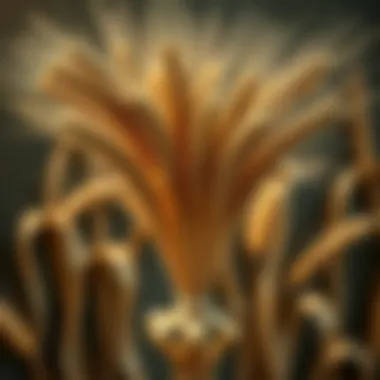Wheat Wedding Bouquets: Beauty Meets Sustainability


Intro
Wheat is a crop that has followed humanity through ages, symbolizing prosperity, nourishment, and unity. When it comes to weddings, using wheat in bouquets has gained traction for its unique aesthetic appeal and cultural significance. These floral arrangements go beyond mere decoration; they evoke traditions and foster connections to nature, all while serving a functional purpose.
In recent years, with the spotlight on sustainability, more couples are recognizing the beauty and practicality of incorporating wheat. This article provides insights and thoughtful strategies for creating wheat wedding bouquets, exploring current trends and sustainable practices that are reshaping how we view floral arrangements in weddings. Let's unravel the various aspects that make wheat an enticing choice for modern weddings.
Foreword to Wheat Wedding Bouquets
Wheat has, for centuries, been deeply woven into the fabric of various cultures and practices, and its emergence as a popular choice for wedding bouquets highlights this connection. The choice to incorporate wheat into floral arrangements radically transforms the aesthetics of a wedding while also commenting on broader historical and cultural narratives. This choice stands out not just in its visual allure but also in the symbolism it carries, producing a unique and engaging option for couples looking to symbolize their union.
In the world of wedding planning, where trends can be as fleeting as morning dew, wheat bouquets rest on a sturdy foundation of traditional symbolism. The golden hue and rustic charm of wheat can evoke feelings of warmth and homeliness, making it an optimal selection for outdoor ceremonies or rural-themed celebrations. Moreover, the versatility of wheat blends seamlessly with various floral elements, allowing couples to craft a bouquet that not only suits their tastes but also tells a unique story.
The focus shifts to practical considerations as couples navigate the complexities of planning a wedding. Selecting wheat as a principal design element not only enhances the visual charm of a bouquet but also aligns with sustainable practices that many modern couples advocate. Making eco-conscious choices is a prevailing theme today, giving wheat an edge for couples mindful of their environmental impact.
Designing the Wheat Bouquet
Designing a wheat bouquet is not just about putting together some flowers; it's about striking a balance between aesthetic beauty and practical considerations. The way wheat is integrated into wedding bouquets has evolved, allowing couples to express their individuality while being mindful of sustainability. The design process offers a canvas for creativity, enabling various textures, colors, and styles to come together seamlessly. Such thoughtful craftsmanship elevates the wheat bouquet from mere decoration to a symbol of love and commitment.
Selecting the Right Wheat Varieties
Types of Wheat for Bouquets
The choice of wheat variety plays a crucial role in the overall look and feel of the bouquet. Common types used include common wheat, durum wheat, and amber wheat. Each brings its unique characteristics. Common wheat, for instance, is popular for its availability and sturdiness, making it an easily accessible option for many. On the other hand, durum wheat is admired for its robustness; it holds up well in floral arrangements and can withstand the passage of time. The selection may come down to how each variety resonates with the envisioned theme of the wedding event.
Color Variations
Wheat also has intriguing color variations that can impact the aesthetic appeal of a bouquet. While the typical hue is a soft golden-yellow, you might come across a diverse palette from green immature wheat to deep amber shades. Using colored wheat can add depth to the arrangement and provide contrast against fresh flowers. These variations allow couples to incorporate personal colors or motifs significant to their relationship, further customizing their big day.
Texture and Structure
The texture of wheat stems and heads also has its charm. Laminated or dried wheat provides a rustic texture that can enhance the bouquet's overall structure. Incorporating these elements can create a sense of dimension and varying visual interest. While the structure of wheat is predominantly linear, it can contrast beautifully with rounder floral elements, enabling a striking interplay that captivates the eye. Choosing the right texture is fundamental in crafting an appealing visual narrative.
Incorporating Other Floral Elements
Complementary Flowers


Adding complementary flowers is another way to elevate a wheat bouquet. Flowers such as lavender, baby's breath, and sunflowers work beautifully with wheat due to their distinct colors and sizes. Lavender infuses the bouquet with a soothing scent while adding a soft touch, and sunflowers can introduce a cheerful vibe. Each flower type not just fills gaps but tells its own story while enhancing the overall message of the bouquet.
Seasonal Foliage
When considering seasonal foliage, options like eucalyptus or maple leaves can bring a dynamic element to the arrangement. Seasonal foliage adds a richness that enhances the bouquet's color and texture. It's also a practical choice, as it’s readily available and often less expensive, allowing for cost-effective yet lush designs. Reflecting the seasons not only beautifies but deepens the emotional connection to the wedding day.
Color Schemes
Selecting a cohesive color scheme is vital for achieving a harmonious bouquet. Couples should consider hues that resonate well with both the wheat and the chosen flowers. For instance, pairing wheat’s golden tones with pastel flowers can create a pastel meadow effect, while dramatic reds and deep greens can invoke a more vibrant, autumnal look. Having a well-thought-out color scheme ensures that the bouquet aligns with the wedding's overall aesthetic.
Creating Balance and Proportion
Arranging Techniques
Various arranging techniques can bring professional flair to a simple wheat bouquet. Techniques such as spiral or mound can create a visually appealing flow while allowing for balanced integration of wheat and other floral elements. A well-balanced arrangement draws attention to key areas while keeping the eyes moving through the ultimate bouquet's design. The arrangement shouldn't feel lopsided or overwhelmed; rather, it should come together like a well-rehearsed performance.
Size Considerations
Size matters in bouquet design. An oversized bouquet may overshadow the bride, while a too-small bouquet can look lost. The bouquet should complement the bride’s stature and gown. Additionally, larger bouquets can add a wow factor, but they should still be practical for carrying throughout an event. Choosing the right size ensures not only visual appeal but also comfort during the ceremony.
Visual Weight
Visual weight can dramatically affect how a bouquet is perceived. The distribution of flowers, wheat, and foliage contributes to this weight. For example, a bouquet with bulkier flowers can balance the linear appearance of wheat, creating an even distribution that is easy on the eyes. Ensuring that visual weight is taken into account results in proportionate bouquets that naturally attract attention without overpowering or underwhelming.
Cultural Significance of Wheat Bouquets
Wheat bouquets carry a weighty symbolism that stretches across centuries, making them a compelling choice for modern wedding arrangements. Their cultural significance goes beyond aesthetics; it roots itself deeply in history, tradition, and practicality. This section delves into how wheat, as a component in wedding bouquets, has evolved, highlighting its still-relevant role in various ceremonies and the narratives they convey.
Wheat in Historical Context
Ancient Practices
In many ancient civilizations, wheat stood as a symbol of fertility and bounty. For instance, in Mesopotamia, scenes carved on clay tablets depicted wheat as a staple in rituals that celebrated the harvest. The sentiment behind using wheat in weddings stemmed from its connection to life and sustenance. This practice emphasizes the importance of agriculture in nurturing communities, enhancing the overall theme of unity and family. A unique feature of these ancient practices is how they intertwined farming techniques with cultural celebrations, showcasing a robust bond with the land. This feature also underscores the concept that weddings are not only personal events but also communal celebrations rooted in shared values and histories.
Regional Variations


Wheat's role in marriage ceremonies varies significantly across cultures, highlighting regional uniqueness in how these practices are observed. For example, in Eastern Europe, the ritual of weaving wheat into intricate designs for bridal crowns emphasizes honor and prosperity. Conversely, in some parts of Africa, it might be used in more utilitarian arrangements, contributing to food during post-wedding feasts. The diversity found within these regional expressions speaks volumes about the adaptability of wheat as a cultural symbol. Each variation offers its own advantages and disadvantages—while some customs enhance the marital significance, others may be seen as less meaningful or outdated, requiring a careful balance between tradition and contemporary relevance.
Cultural Celebrations
Wheat also features prominently in various cultural celebrations that are aimed at reinforcing familial bonds and communal ties. For instance, during the Italian "corteo" weddings, wheat is integrated into decorative aspects to bless the union with abundance. In many cultures worldwide, including end-of-harvest festivals, wheat is a means to express gratitude and wish for future prosperity. The significance in modern weddings ties back to these celebrations, effectively merging the past with the present. The challenge lies in choosing how much of these symbols to lean on; while some brides may appreciate the depth of historical context, others might prefer a more streamlined interpretation that aligns with their personal beliefs.
Modern Usage in Weddings
Trends in Contemporary Weddings
In recent years, the integration of wheat into wedding themes has spiked, effectively bridging traditional values with modern tastes. Couples often seek to incorporate elements that reflect sustainability, and wheat fits that bill nicely. The trend of using locally sourced or organic wheat can reflect a commitment to environmentally conscious practices. This trend not only represents aesthetic choices but also intertwines with wider discussions about health and sustainability. However, it's essential for each couple to navigate these trends judiciously — not every "trend" will provide meaning or authenticity to everyone’s personal story.
Symbolism in Ceremonies
The symbolism inherent to wheat during wedding ceremonies often focuses on prosperity and fertility, making it particularly appealing to couples beginning their new journey. It can serve as a gentle reminder of nature's cycles and the interdependence between humanity and agriculture. Selecting wheat as part of the bouquet can align with individual or family values aimed at honoring the past while looking toward the future. Yet, brides must consider how much they resonate with these meanings — while some may find comfort in these symbols, others may look for more personal expressions in their wedding choices.
Global Celebrations
The global embrace of wheat in wedding celebrations showcases its universal appeal. From the wheat-laden festivities in rural China to the sumptuous wedding feasts in the Mediterranean, every culture has found a way to integrate this grain into their ceremonies. Such widespread use across the globe illustrates the strength of wheat in connecting different peoples through shared heritage. Nevertheless, navigating these multicultural contexts can sometimes be overwhelming. Couples are often tasked with choosing which elements matter to them, potentially diluting the meaning if not aligned with personal values.
"Wheat stands not just as a grain, but as a cultural quilt that threads together diverse traditions and modern practices."
Practical Considerations
Practical considerations are essential when integrating wheat into wedding bouquets. These aspects not only influence the aesthetic appeal of the arrangements but also impact their sustainability and longevity. For couples looking to create unique experiences on their special day, understanding these practical components can help them make informed decisions about their floral choices.
Harvesting and Sourcing Wheat
Sustainable Farming Practices
Sustainable farming practices in wheat cultivation focus on methods that protect the environment and promote biodiversity. This approach prioritizes techniques such as crop rotation, reduced pesticide use, and soil conservation. These practices are particularly beneficial for wheat bouquets, as healthier crops lead to more vibrant and resilient stems and grains. Moreover, sustainable methods ensure that the resources our future generations rely on remain intact. Many couples are now opting for wheat sourced from farms that practice sustainable agriculture, which enhances the overall message of their wedding—one of responsibility and care for the earth.
Local Sourcing
Sourcing wheat locally can significantly impact the freshness and quality of wedding bouquets. Local farms often harvest their crops closer to the time of the wedding, resulting in bouquets that are not only more visually appealing but also have a longer lifespan. Additionally, supporting local farmers fosters community relationships and contributes to local economies. The unique feature of local sourcing is its ability to highlight regional wheat varieties, allowing each couple to taste a bit of their locale in their arrangements. While it may limit the available types of wheat, the benefits far outweigh this minor drawback.


Seasonal Availability
The beauty of using wheat in bouquets also ties closely to seasonal availability. Harvests vary throughout the year, which means that the best wheat will typically be in season. Couples can use this knowledge to their advantage by selecting wheat varieties that bloom during their wedding season, showcasing the natural palette of the time. Not only does this enhance the bouquet's look, but it also ensures sustainability by minimizing carbon footprints that come from transporting wheat from distant locations. Although planning according to seasonality may require a bit more foresight, the payoff is well worth any efforts.
Maintaining Freshness and Durability
Preservation Techniques
To maintain the freshness of wheat bouquets, various preservation techniques can be employed. Techniques such as drying, using silica gel, or employing glycerin solutions help retain the natural beauty and color of the wheat. These methods extend the life of a bouquet and allow couples to revisit their special day long after it has passed. The challenge with preservation, however, lies in choosing the correct technique for the desired aesthetic. It's vital to carefully research which method meshes well with the intended final look of the bouquet.
Care Tips for Longevity
Proper care is fundamental for ensuring the longevity of wheat bouquets. Items like spraying the grains lightly with water to mimic natural moisture or storing the bouquet in a cool, dry place can make a considerable difference. Keeping bouquets out of direct sunlight also helps prevent fading. For couples, practicing these simple care methods not only helps their bouquets last longer but allows them to cherish their beautiful arrangements for years to come. The drawback, though, is that people may not always remember to provide care, which can lead to flowers wilting or degrading more rapidly.
Post-Wedding Options
After the wedding, couples often wonder what to do with their bouquets. Wheat bouquets lend themselves well to creative post-wedding options, such as using the wheat in home decor or even replanting them. This can be an avenue for couples to continue their commitment to sustainability while cherishing memories from their special day. However, some couples might find themselves at a loss for options, so researching ideas beforehand can be beneficial. Ultimately, staying engaged with one's choices can enhance the overall experience.
The decision to use wheat in wedding bouquets is about more than just looks; it encompasses considerations of sustainability and tradition.
Ending
In this exploration of wheat wedding bouquets, we have highlighted a blend of tradition, aesthetic appeal, and practical considerations that define this unique floral arrangement. Wheat symbolizes more than just a plant; it embodies fertility, abundance, and a rich history intertwined with various cultures. Couples seeking to incorporate wheat into their wedding bouquets should consider these elements—not just for their visual impact but also for the deeper meanings they carry.
Embracing Innovation in Tradition
Modern weddings often seek to strike a balance between personal expression and traditional practices. The integration of wheat into bouquets represents a renewed interest in symbolic materials that harken back to historical roots while allowing for creative innovation. When couples embrace wheat in their arrangements, they are not only paying homage to agricultural heritage but also making a statement that prioritizes sustainability.
Adopting unconventional methods to display wheat can breathe fresh life into the traditions. For instance, wheat can be mixed with locally sourced flowers or even dried herbs to create a bouquet that not only looks beautiful but also tells a story of local culture and farming practices. Some couples opt for handpicked wildflowers to complement the golden hue of wheat, making their bouquet a unique work of art that fits the personality of both partners.
Additionally, floral designers are beginning to explore modern techniques such as using preserved wheat and combining it with contemporary materials, which opens up a new realm of possibilities for design. This innovation ensures that wheat bouquets are not merely a nod to the past but a forward-thinking choice that enriches modern celebrations.
The Future of Wheat Bouquets
Looking ahead, the trend of using wheat in wedding bouquets seems set to grow, particularly as awareness of sustainability and local sourcing continues to rise. More couples are prioritizing their environmental footprint, searching for ways to connect their celebrations with nature and support local farmers.
Moreover, educational platforms and online communities are fostering a growing interest in agricultural practices and the importance of seasonal flowers. Couples are becoming more informed consumers, understanding the implications of their choices in the context of both climate and local farming communities. This encourages the adoption of sustainable practices not only in bouquets but across the entire wedding industry.
"The wedding industry is undergoing a transformation where beauty meets responsibility, and wheat may just be the star of the show."
As more resources and workshops become accessible, we may see a surge in personal creativity surrounding wheat bouquets. This could include DIY approaches, educational sessions on floral arranging, or even collaborations with local farms. The potential for educational initiatives to connect future generations to the artistry of bouquet design is immense. Thus, the future of wheat wedding bouquets is not just about style; it's about creating a deeper connection between people, their communities, and the land they cherish.







